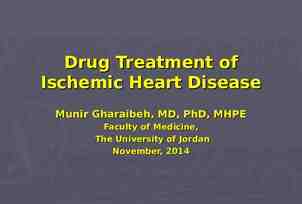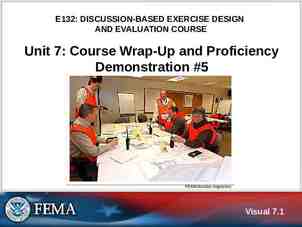An overview of fatal injury surveillance in South Africa
24 Slides811.50 KB
An overview of fatal injury surveillance in South Africa Cuernavaca, Mexico, 1-2 June 2005 Richard Matzopoulos CRIME, VIOLENCE AND INJURY LEAD PROGRAMME Medical Research Council University of South Africa Institute for Social and Health Scie
National Injury Mortality Surveillance System (NIMSS) strengths and weaknesses strategic challenges future plans for the NIMSS
history 1993 –1995 Cape Town 1998 – 2 years of DACST funding national pilot – Gauteng, Durban, CT 1999 – 1st annual report – Kimberley, PE, EL 10 mortuaries, 5 provinces 2000 – 2nd report – Gauteng, PE 15 mortuaries, 5 provinces 2001 – 3rd report – Durban, EL, Mpumalanga 32 mortuaries, 6 provinces
Coverage Non-natural mortality 68 930 (MRC Burden of Disease, 2000) 12 to 15 %of all mortality NIMSS 24 600 / 68930 36% Rural: 5-6%, Urban: 55-64%
Coverage Mainly urban Metros - Johannesburg, Durban, Cape Town, Pretoria, Port Elizabeth, Erkhuruleni Cities – East London/KWT/Bisho, Kimberley Rural towns Mpumalanga, Stellenbosch, Potchefstroom, Kroonstad, Nelspruit 7 out of 9 provinces represented Warehoused at MRC Report- generating software
Typology of injury Intentional / violence Unintentional / “accidental” Self-directed Traffic Interpersonal Other unintentional Collective External cause Firearm Sharp force Hanging Drowning Demographics Age Population group Sex Event Place Blood alcohol Forensic info
External cause of death (N 22 248) Firearms 6167 Sharp f orce injury 3276 Pedestrian 2642 Blunt f orce injury 1565 MV unspecif ied 1400 Burns 1175 Hanging 1083 Ingested Poison 429 Drowning 406 Railway 376 Other 3729 0 1000 2000 3000 4000 5000 Number of deaths 6000 7000
External cause of death among males (N 17 932) Firearms 5465 Sharp force injury 2868 P edestrian 1965 Blunt force injury 1268 M V unspecified 1064 Hanging 951 M V driver 895 Burns 728 M V passenger 616 327 Drowning 1785 Other 0 1000 2000 3000 4000 Number of deaths 5000 6000
External cause of death among females (N 4076) P edestrian 645 Firearms 643 Burns 440 P assenger 402 Sharp force injury 385 M V unspecified 323 276 Blunt force injury Ingested P oison 171 Hanging 120 117 Driver 554 Other 0 100 200 300 400 500 Number of deaths 600 700
Overall apparent manner of death (N 22 248) Other 11% Violence 48% Transport 30% Suicide 11% Source: National Injury Mortality Surveillance System, 2003
Fatal injury rates / 100 000 population C.T. Jhb Pret Durb Overall 138 134 97 131 Violence 66 52 24 61 Suicide 11 15 14 14 Transport 33 37 34 34 - drivers 4 5 5 4 - pedestrians 17 16 12 17
Transport User by BAC (n 2953) 100% 50% 0% Pedestrian Zero Passenger 0.01 – 0.04 0.05 – 0.14 Driver 0.15 – 0.24 Transport User by BAC, NIMSS, 2003 Railway 0.25
National Injury Mortality Surveillance System (NIMSS) strengths and weaknesses strategic challenges future plans for the NIMSS
strengths and weaknesses Data quality and coverage Detailed info on who, what, when, where Mortuary catchment and population data questionable (minimised by city coverage) No gold std for apparent manner of death Resource for specialised studies Mainly urban - complete datasets for major cities Rural sites difficult to establish and maintain Representivity Comparability (correlates with ICD coding) Sustainability Standardised (manuals, procedures, storage, reporting) Cost 80 000 p.a. (incl staff, reports, media, etc) widely used / generates considerable publicity – protective factors
National Injury Mortality Surveillance System (NIMSS) strengths and weaknesses strategic challenges future plans for the NIMSS
strategic challenges Competing data and interests StatsSA – national (90%), 16 yrs, no manner / external CoD police – national, underreporting, criminal justice, form-based transport – national, reliant on police, detailed info, substantial underreporting Sensationalism vs rationalism Media focus on high rates and not public health utility DoH and other govt depts feel threatened Sustainability Limited funding prevents expansion Relocation of mortuaries from police to health (turf ?) Data to action 3 tiers of government City focus for 2010 world cup
National Injury Mortality Surveillance System (NIMSS) strengths and weaknesses strategic challenges future plans for the NIMSS
Focus on cities city infrastructure accessible responsive well established and centralised documentation of strategies and challenges coordinated information systems amenable to personal and consultative interaction 2003 annual report initial commitment to city focus National injury profile City specific rates (Jhb, Durb, CT, Pret) Separate city-reports (chapters 3-6) transfer to DoH?
Proposed future location of NIMSS Health Facility Regional Home Affairs Office National Home Affairs Office Statistics South Africa Doctor NIMSS data set NIMSS (MRC/UNISA and DoH) Headman Mortuary DoH Regional co-ordinator Data entry at site / regional? NIMSS resp. in job description NIMSS collection at all mortuaries sites MRC/UNISA Data warehouse Report-generation Analytic research City-level prevention Mortuary-specific reports sites City reports Safe city initiatives NIMSS annual report National violence and injury prevention
Thank You Special thanks are due to the staff of the mortuaries and forensic laboratories that participated in the compilation of the NIMSS data. We hope that the NIMSS will eventually play a part in reducing their considerable workload.
Data to Action - Securing Safety as a right 8th World Conference on Injury Prevention & Safety Promotion ICC, Durban, South Africa 2 - 5 April 2006 www.safety2006.info
Data to Action - Securing Safety as a right Conference Profile: 2000 131 350 1500 100 Participants from Countries Oral presentations Posters Exhibitors Co-hosts Sponsor World Health Organization
Data to Action - Securing Safety as a right Conference Objectives: Translate injury data into prevention actions - Critical review of approaches Foster exchanges in all fields of injury prevention and safety promotion Examine critical applications of injury prevention and safety promotion practices for different regions of the world Stimulate/strengthen injury prevention and safety promotion as central to national, continental & international public health policies and programmes Create opportunities for multidisciplinary and crosssectoral dialogue Highlight international injury prevention milestones and possibilities for innovation
Data to Action - Securing Safety as a right See you at ICC, Durban, South Africa from 2 - 5 April 2006 For more information visit www.safety2006.info





























